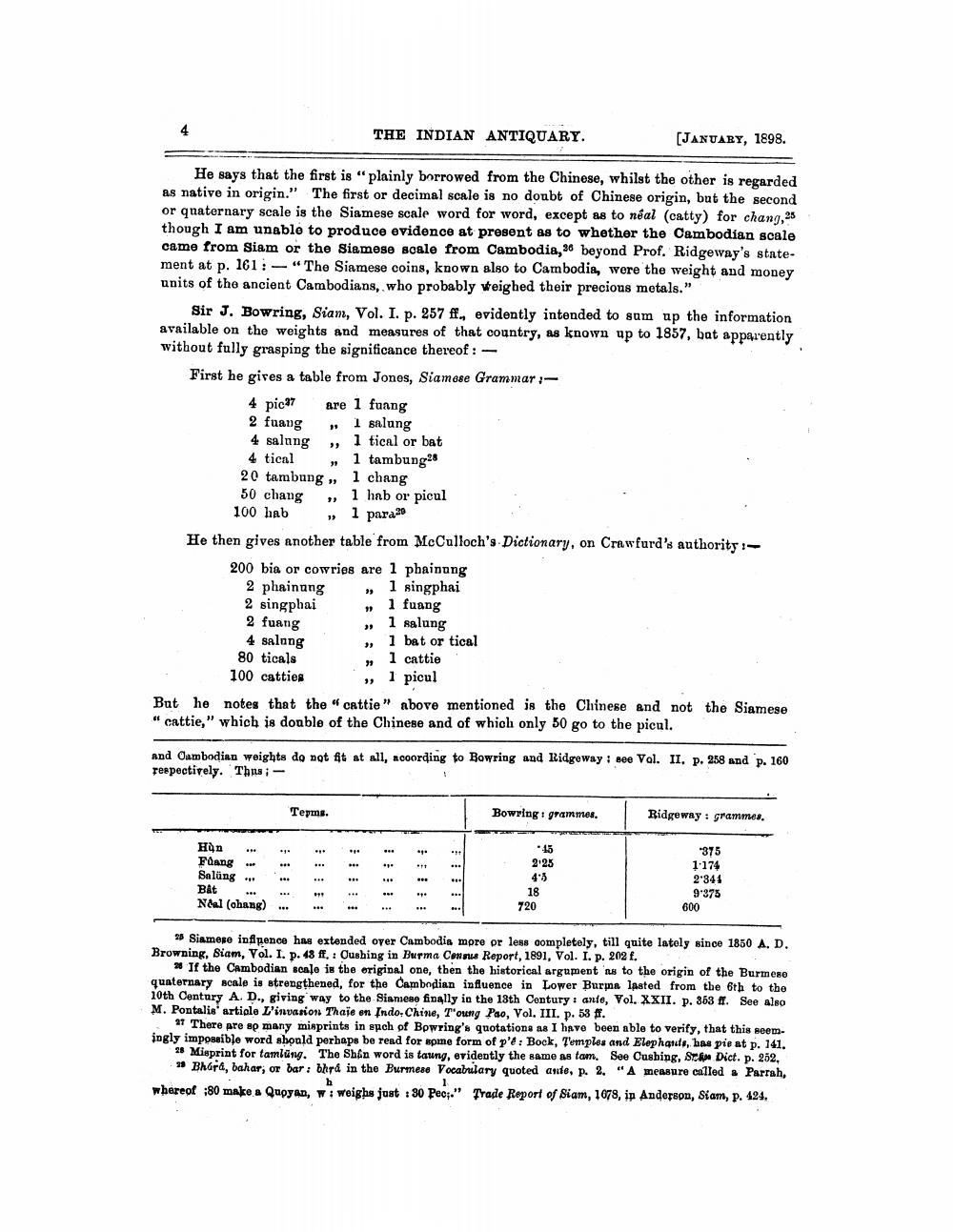Book Title: Indian Antiquary Vol 27 Author(s): Richard Carnac Temple Publisher: Swati Publications View full book textPage 8
________________ THE INDIAN ANTIQUARY. (JANUARY, 1898. He says that the first is "plainly borrowed from the Chinese, whilst the other is regarded as native in origin." The first or decimal scale is no doubt of Chinese origin, but the second or quaternary scale is the Siamese scale word for word, except as to néal (catty) for chang, 25 though I am unable to produce evidence at present as to whether the Cambodian scale came from Siam or the Siamese scale from Cambodia, 26 beyond Prof. Ridgeway's statement at p. 161: -“The Siamese coins, known also to Cambodia, were the weight and money units of the ancient Cambodians, who probably weighed their precious metals." Sir J. Bowring, Siam, Vol. I. p. 257 ff., evidently intended to sum up the information available on the weights and measures of that country, as known up to 1857, bat apparently without fully grasping the significance thereof: - First he gives a table from Jones, Siamese Grammar : 4 pic7 are 1 fuang 2 fuang salung 4 salung 1 tical or bat 4 tical , 1 tambung? 20 tambung l chang 50 chang 1 hab or pical 100 hab 1 para2 He then gives another table from McCulloch's Dictionary, on Crawfurd's authority : 200 bia or cowries are 1 phainung 2 phainang » 1 singphai 2 singphai 1 fuang 2 fuang , 1 salung 4 salong » 1 bat or tical 80 ticals 1 cattie 100 catties , 1 picul But he notes that the “cattie" above mentioned is the Chinese and not the Siamese "cattie," which is double of the Chinese and of which only 30 go to the picul. and Cambodian weights do not fit at all, acoording to Bowring and Ridgeway: see Vol. II, p. 258 and p. 160 respectirely. Thnsi Tepms. Bowring grammes. Ridgeway : grammes. 2.25 Hon Flang... Salung ... BAt Neal (chang) 375 1.174 2-344 9375 600 ... . 18 720 * Siamese influence has extended over Cambodia mpre pr less completely, till quite latoly since 1850 A. D. Browning, Siam, Vol. I. p. 48 ff. : Oushing in Burma Census Report, 1891, Vol. I. p. 202 f. * If the Cambodian scale is the original one, then the historical argument to the origin of the Burmese quaternary scale is strengthened, for the Cambodian influence in Lower Burma lasted from the 6th to the 10th Century A D ., giving way to the Siamese finally in the 18th Contury: ante, Vol. XXII. p. 363 A. See also M. Pontalis' article L'invasion Thaje en IndoChine, Toung Pao, Vol. III. p. 58 ff. 91 There are so many misprints in epch of Bpwring's quotations as I have been able to verify, that this seemingly impossible word should perhaps be read for apme form of pie : Bock, Temples and Elephards, bae pie at p. 141. Misprint for tamlúng. The Shin word is taung, evidently the same as tam, See Oushing, SA Dict. p. 252. » Bhora, bahar, or bar: bhra in the Burmese Vocabulary quoted ante. p. 2. "A measure called Parrah, whereof 180 make a Quoyan, w: weighs just : 30 Peopo" Trade Report of Siam, 1078, ip Anderson, Siam, p. 424,Page Navigation
1 ... 6 7 8 9 10 11 12 13 14 15 16 17 18 19 20 21 22 23 24 25 26 27 28 29 30 31 32 33 34 35 36 37 38 39 40 41 42 43 44 45 46 47 48 49 50 51 52 53 54 55 56 57 58 59 60 61 62 63 64 65 66 67 68 69 70 71 72 73 74 75 76 77 78 79 80 81 82 ... 404
